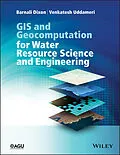Barnali Dixon is a Professor in the Department of Environmental Science, Policy and Geography at the University of South Florida St. Petersburg (USFSP) and the Director of the Geospatial Analytics Lab of USFSP.
Venkatesh Uddameri is a Professor in the Department of Civil, Environmental and Construction Engineering at Texas Tech University and the Director of the TTU Water Resources Center.
Autorentext
BARNALI DIXON is a Professor in the Department of Environmental Science, Policy and Geography, University of South Florida St. Petersburg (USFSP) and the Director of the Geospatial Analytics Lab of USFSP.
VENKATESH UDDAMERI is a Professor in the Department of Civil, Environmental and Construction Engineering at Texas Tech University and the Director of the TTU Water Resources Center.
Klappentext
GIS and Geocomputation for Water Resource Science and Engineering
GIS and Geocomputation for Water Resource and Science Engineering not only provides a comprehensive introduction to the fundamentals of geographic information systems but also demonstrates how GIS and mathematical models can be integrated to develop spatial decision support systems to support water resources planning, management, and engineering. The book uses a hands-on active learning approach to introduce fundamental concepts and numerous case studies are provided to reinforce learning and demonstrate practical aspects. The benefits and challenges of using GIS in environmental and water resources fields are clearly tackled in this book, demonstrating how these technologies can be used to harness increasingly available digital data to develop spatially oriented sustainable solutions. In addition to providing a strong grounding on fundamentals, the book also demonstrates how GIS can be combined with traditional physics-based and statistical models as well as information-theoretic tools like neural networks and fuzzy set theory.
Zusammenfassung
GIS and Geocomputation for Water Resource Science and Engineering not only provides a comprehensive introduction to the fundamentals of geographic information systems but also demonstrates how GIS and mathematical models can be integrated to develop spatial decision support systems to support water resources planning, management and engineering. The book uses a hands-on active learning approach to introduce fundamental concepts and numerous case-studies are provided to reinforce learning and demonstrate practical aspects. The benefits and challenges of using GIS in environmental and water resources fields are clearly tackled in this book, demonstrating how these technologies can be used to harness increasingly available digital data to develop spatially-oriented sustainable solutions. In addition to providing a strong grounding on fundamentals, the book also demonstrates how GIS can be combined with traditional physics-based and statistical models as well as information-theoretic tools like neural networks and fuzzy set theory.
Inhalt
Preface xiii
About the Companion Website xv
List of Acronyms xvii
Part I GIS, Geocomputation, and GIS Data 1
1 Introduction 3
1.1 What is geocomputation? 3
1.2 Geocomputation and water resources science and engineering 4
1.3 GIS-enabled geocomputation in water resources science and engineering 5
1.4 Why should water resources engineers and scientists study GIS 5
1.5 Motivation and organization of this book 6
1.6 Concluding remarks 7
References 9
2 A Brief History of GIS and Its Use in Water Resources Engineering 11
2.1 Introduction 11
2.2 Geographic Information Systems (GIS) - software and hardware 11
2.3 Remote sensing and global positioning systems and development of GIS 12
2.4 History of GIS in water resources applications 13
2.5 Recent trends in GIS 19
2.6 Benefits of using GIS in water resources engineering and science 20
2.7 Challenges and limitations of GIS-based approach to water resources engineering 20
2.8 Concluding remarks 23
References 25
3 Hydrologic Systems and Spatial Datasets 27
3.1 Introduction 27
3.2 Hydrological processes in a watershed 27
3.3 Fundamental spatial datasets for water resources planning: management and modeling studies 28
3.4 Sources of data for developing digital elevation models 30
3.5 Sensitivity of hydrologic models to DEM resolution 31
3.6 Accuracy issues surrounding land use land cover maps 32
3.7 Sensitivity of hydrologic models to LULC resolution 34
3.8 Sources of data for developing soil maps 36
3.9 Accuracy issues surrounding soil mapping 37
3.10 Sensitivity of hydrologic models to soils resolution 38
3.11 Concluding remarks 43
References 44
4 Water-Related Geospatial Datasets 47
4.1 Introduction 47
4.2 River basin, watershed, and subwatershed delineations 47
4.3 Streamflow and river stage data 48
4.4 Groundwater level data 48
4.5 Climate datasets 48
4.6 Vegetation indices 49
4.7 Soil moisture mapping 49
4.8 Water quality datasets 51
4.9 Monitoring strategies and needs 51
4.10 Sampling techniques and recent advancements in sensing technologies 52
4.11 Concluding remarks 53
References 53
5 Data Sources and Models 55
5.1 Digital data warehouses and repositories 55
5.2 Software for GIS and geocomputations 55
5.3 Software and data models for water resources applications 59
5.4 Concluding remarks 60
References 60
Part II Foundations of GIS 61
6 Data Models for GIS 63
6.1 Introduction 63
6.2 Data types, data entry, and data models 63
6.3 Categorization of spatial datasets 65
6.4 Database structure, storage, and organization 71
6.5 Data storage and encoding 75
6.6 Data conversion 76
6.7 Concluding remarks 78
References 80
7 Global Positioning Systems (GPS) and Remote Sensing 81
7.1 Introduction 81
7.2 The global positioning system (GPS) 81
7.3 Use of GPS in water resources engineering studies 82
7.4 Workflow for GPS data collection 83
7.4.1 12 Steps to effective GPS data collection and compilation 83
7.5 Aerial and satellite remote sensing and imagery 83
7.6 Data and cost of acquiring remotely sensed data 84
7.7 Principles of remote sensing 85
7.8 Remote sensing applications in water resources engineering and science 88
7.9 Bringing remote sensing data into GIS 91
7.10 Concluding remarks 94
…
